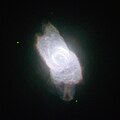Файл:NGC 6572.jpg
NGC_6572.jpg (500 × 500 пиксель, файлан барам: 135 Кб, MIME-тайп: image/jpeg)
Файлан истори
Тlетаlаде терахь/хан, муха хилла хьажарна и файл.
| Терахь/Хан | Жима | Файлан барам | Декъашхо | Билгалдаккхар | |
|---|---|---|---|---|---|
| карара | 2010, 14 декабрь, 17:08 |  | 500 × 500 (135 Кб) | Antonsusi | Better jpg-quality, less environment of no interest |
| 2010, 13 декабрь, 14:59 |  | 629 × 638 (68 Кб) | Jmencisom | {{Information |Description={{en|1=The NASA/ESA Hubble Space Telescope has turned its eagle eye to the planetary nebula NGC 6572, a very bright example of these strange but beautiful objects. Planetary nebulae are created during the late stages of the evol |
Файл лелор
ХӀара файл лахарчу 1 агӀонгахь лелош йу:
Глобалан файл лелор
ХӀара файл лелош йу лахахь гайтина йолу википедеш чохь:
- Лелор ar.wikipedia.org
- Лелор az.wikipedia.org
- Лелор be.wikipedia.org
- Лелор cs.wikipedia.org
- Лелор de.wikipedia.org
- Лелор diq.wikipedia.org
- Лелор en.wikipedia.org
- Лелор fa.wikipedia.org
- Лелор fr.wikipedia.org
- Лелор hr.wikipedia.org
- Лелор it.wikipedia.org
- Лелор it.wikibooks.org
- Лелор kk.wikipedia.org
- Лелор mk.wikipedia.org
- Лелор nl.wikipedia.org
- Лелор pl.wikipedia.org
- Лелор pt.wikipedia.org
- Лелор ru.wikipedia.org
- Лелор sk.wikipedia.org
- Лелор tr.wikipedia.org
- Лелор tt.wikipedia.org
- Лелор www.wikidata.org
- Лелор zh.wikipedia.org

